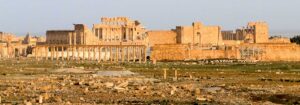Friday, April 13, 2029, will be a showtime for asteroid Apophis, for the general public and astronomers alike. Apophis will come so close that it’ll be visible to the unaided eye alone; something that almost never happens with asteroids. It will appear first in the Southern skies and seem to streak across the Pacific Ocean and America before orbiting off to outer space. During this time the Earth’s motion will cause the asteroid to shake if not stir.
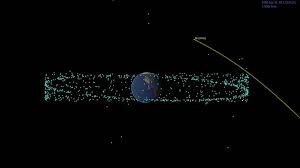
Apophis is 320 metres across and if it struck the Earth it would have a circumferential destructive effect of several hundred kilometres from where it hit. Instead, it is predicted to miss by the predicted 13,000 kilometres.
The asteroid first attracted community attention in 2004 when its orbit, in relation that of Earth, became a matter of controversy. It should be noted that Easter day in 2029 falls on April 1.
Endangered Elements
The idea that there are endangered elements that could face a severe shortage in 100 years does not warrant the interest of other “endangered species”. There are nine listed as “endangered”, which sounds quaint when the world is failing because of the atmospheric pollution due to other elements – notably the products of the ubiquitous carbon and nitrogen.
In any event, the “endangered” nine are arsenic, gallium, germanium, gold, hafnium, helium, indium, tellurium and zinc.
Indium was an elusive element and it was not separated from other metals until 1863. It was named indium because examination of it spectroscopically showed a very prominent indigo spectral line.
In May 2007, the New Scientist reported that a material chemist at the University of Augsberg in Germany reported that the world would run out of indium within ten years. The price was over $1000 per kg at the time.
Fourteen years on, and the world has not run out of indium. Most of the indium is stored in China. Its price does not appear on most stock markets as only about 800 tonnes is produced each year. A particular platform underwritten by the Chinese government tried to corner the market, by stockpiling tons of the stuff – and then despite an artificially created shortage found that the price which had soared to its highest level in 2005, fell which is not what it was supposed to do.
Indium is alloyed with tin and oxygen to form the transparent, conductive oxide that coats the screens of TVs, mobiles and laptops. The element is also used in infrared lasers that transmit data down optical fibres that enable the Internet. In combination with gallium, it is used to make the LEDs that backlight screens and are increasingly used for domestic lighting.
Indium (atomic no 49) has the unusual property when molten of clinging to (wetting) clean glass and other surfaces; this makes it valuable for producing hermetic seals between glass, metals, quartz, ceramics and marble. Its use has given it an aura of indispensability, but as with the 1972 MIT thesis adopted by the Club of Rome that the world would soon run out of crucial resources, this did not eventuate. The world is now more concerned not with quantity but with the quality of the output. Indium as the elemental metal is toxic if ingested; left in the ground it remains locked up, even if it is becoming an “endangered species”.
Predictions of it becoming an extinct species have been revised upwards and the new prediction is now 2025. However, indium is being recycled and even other elements such as silver which are more plentiful have been substituted in manufacturing. Thus, all the world can breathe a collective sigh (at least among the cognoscenti). Indium may remain endangered but is not a metallic dodo.
I should hasten to add that does not imply that the endangered elements will disappear from the Earth completely. It means that there will come a point when the supply of these elements will be limited or when it is no longer economically viable to extract or use these elements. At such a juncture, we will have to seek alternatives, as has occurred with indium.
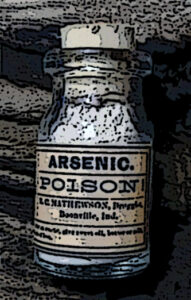
Arsenic always gets a bad press. A beloved poison of the mystery writers, yet once used as a medication for syphilis, it is also a contaminant of waterways because it is used in the production of gold. I find it somewhat surprising that arsenic which has been used as a pesticide, especially in treating wood in particular – rather than rats – is endangered. Arsenic is very toxic, yet I find it difficult to believe it is considered an endangered element, given how many rivers and wells are contaminated around the world – just ask those living in rural Bangladesh and Taiwan.
Arsenic is often used as a doping agent for solid-state devices such as transistors. Doping is the intentional introduction of impurities into an intrinsic semiconductor for the purpose of modifying its electrical, optical and structural properties. It seems to me the new alchemy, but it seems also that there is a degree of elemental interchangeability. It is not the inflexibility of turning lead into gold.
Some time ago, I wrote a blog on another endangered element, hafnium. Australia has some of the biggest deposits of this rare element, which is found as the junior partner in zirconium ore. Purification is very costly and, by its nature, potentially detrimental to the environment. As I have written, hafnium is used in the manufacture of nuclear reactor rods, and a pilot project employing hafnium was set up over a decade ago at the Australian Nuclear Science and Technology Organisation (ANSTO).
Where is this all going? It’s elementary, dear Watson. But only if the world lasts another century in its current form with just so many cowboys and indiums.
Remembering Latvia
I have previously written about touring the Baltic countries, and at this time when there is disturbance in the region again, Latvia has a special significance. It has more Russian-speaking inhabitants than the other two Baltic countries. Hence, it is regarded with some caution by the other two – the object of the sidelong glance.
The whole area again has attracted attention because of the current confrontation on a Byelorussian border and Poland in particular, but also Lithuania.
Latvia sits on the sidelines. Prior to COVID-19 we travelled to the Baltic countries. Below is a snapshot of Latvia, pre-COVID-19.
We arrived in Latvia and headed for the capital, Riga. One of the most noticeable aspects of this whole drive is the fact that the border changes everything. Estonia does not blend with Latvia nor does Lithuania blend with Latvia; nor Estonia with Lithuania. It is as though there is a cultural crevasse between the three countries. The Estonians relate to the Finns; the Lithuanians to the Poles. And the Latvians? They sit between the two with, as I have noted above, a significant proportion of the population Russian-speaking.
The hotel where we stay in Riga lies at the confluence of roads and away from the city.
In the park across from the hotel are tearooms. My companion looks over the variety of teas. Exotic teas? No, she will have coffee. I order a cute bowl of “rabbit food” – everything including the beans are in miniature in an appropriately small bowl. What a healthy lunch for a dwarf. As we walked away, I am reminded of the true meaning of “famished”.
There are several areas of Riga where these old wooden houses also survive. The wooden house is a characteristic feature of Latvia and I wonder how they survived the wars. They would be so easy to torch, but there are streets of wooden houses, with various degrees of decoration –mostly in brown, but blue is a favourite alternative colour – sky blue to steely blue to presumably match the changing climate.
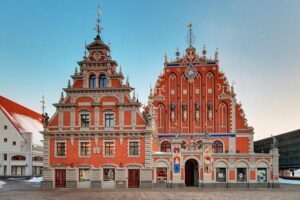
Latvia is the home of amber, and from the selection in a shop inside the wonderfully named House of Blackheads, I purchased a couple of pieces of yellow amber. Amber has always attracted me from the time I was a small boy on first seeing an insect caught in the fossilised pine resin. I remember my mother had a necklace of red amber; amber is always so warm and my mother showed me that after rubbing amber with fur, the amber could attract tiny scraps of paper. It was magic to a small boy. Later I would learn that stroking amber with cloth provided for human curiosity the earliest demonstration of an electrical charge.
One interesting impression of the Baltic countries is even as their existence is threatened by Russian invasion, the whole feeling is one of a fantastical past – a surrogate home for the Pre-Raphaelite movement, where Arthurian Knights would be invited for a guest appearance at some Baltic Armageddon in a joust with a company of Blackheads.
Everywhere there seems to be evidence of mediaeval valour, varlets and knaves, clattering armour, and unmerciful treatment of the vanquished. The House of Blackheads, with its huge façade, draws on all sorts of architecture. It has its curlicues and statues on a bright terracotta coloured façade; and to honour the Blackhead name – an effigy of Saint Maurice, the black saint revered by this coterie of Knights, stands on one side of the front doorway.
The building has been razed several times, the last after the Russians destroyed what the Nazis had missed. The rebuilding program is a tribute to Latvian doggedness. Yet Latvia remains vulnerable to invasion, even though its border with Russia is not as long as the Estonian-Russian border, the latter has a better defence being mostly swamp and marshes. Even so the Estonians are threatening to build a 110 kilometres long fence.
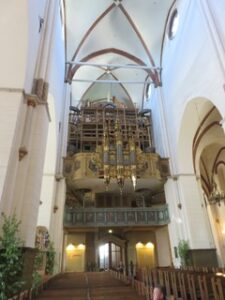
However, Russian influence remains in Latvia. Yet the Riga Cathedral epitomised the strong Lutheran influence and the informality of a kindergarten being located in its precincts.
One morning we journeyed to Jurmala, a seaside resort near Riga, recommended not to be missed.
Our guide pays the toll to reach this littoral enclave. Here is the Russian embassy, a quietly luxurious residence set back from the road. My companion jumps out of the car to photograph it. Our guide looks concerned. But she is back without any fusillade of bullets. It is only the camera that winks at us.
During the Russian occupation, Jurmala was a popular resort with senior officials from the Kremlin. Even now our guide says much of the property in Jurmala is owned by Russian oligarchs.
Our guide, who has an uncanny resemblance to Radar in M.A.S.H., steers us into a wooded area known as the Ragakapa nature park. Here in this reclaimed dune area, we peer through the wire fence at a fishing village which has been created complete with long boats. The exhibit is closed –and that was that. Jurmala was yet to wake up from its winter hibernation. It is a summer resort on the Baltic with a beach, 33 kilometres long –and there are sanatoria, spas, buckets and spades.
Radar is a multi-faceted personality. He talks with the high-pitched voice of his TV twin. He tells he does this job part-time. He is Jewish and he spends his time researching the genealogy of Latvian families, Jews in particular. It keeps him busy particular at the times of the year when there are no tourists. He also claims other ancestors – a very defined group with a long history but now in serious decline.
They are the pure Livonians who are a small group now, but he like many Latvians is proud to claim Livonian heritage, given their long history as Teutonic knights. Its language is akin to Estonian and is classified as “dormant” since the last fluent speaker died two years ago. The Livonians suffered badly under the Russian occupation. Their land is where the Germans made their last stand in Latvia at the end of World War II. Retribution followed.
The Baltic States have been the stage for almost continuous conflict. Yet what cannot be denied is the beauty of the Jurmala setting with its beach, its dunes, its forested environment. And there is something both romantic and nostalgic about places where there are wooden houses.
Yet there, in all this quaintness back in the capital, there is Restorans 3. This restaurant is in Old Riga, itself a convolution of narrow cobbled streets where negotiating them is only for the expert – but eventually the taxi driver finds his way around the tangle of one-way streets and drops us off at this restaurant with its wide picture windows and a kitchen open for customers to see the virtuoso preparation.
We sit by the window. There is only one other customer, a nattily dressed Chinese man, who seems only to be drinking coffee, and soon leaves. For a time we are the only diners as we face the formidable gustatory menu. She avoids the tongue and the ox heart items. She hates tongue; and ox heart is a meat too far. While ostensibly there were five or seven on the tasting menu, by the time we have worked our way through the meal, there were three other courses –including a sorbet intermission.
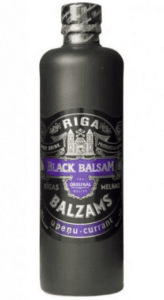 As with all Baltic countries, Latvians love beer. However, there is a Riga drink – balzam. It is a black liqueur. Having been required on a few occasions when as a post-graduate research scholar to take iodine after inadvertently labelling myself with radioactive iodine, I taste the balzam. I am transported back to my heady iodine days. It tastes just as bitter and unpalatable as iodine.
As with all Baltic countries, Latvians love beer. However, there is a Riga drink – balzam. It is a black liqueur. Having been required on a few occasions when as a post-graduate research scholar to take iodine after inadvertently labelling myself with radioactive iodine, I taste the balzam. I am transported back to my heady iodine days. It tastes just as bitter and unpalatable as iodine.
End of story: my first and last drink of balzam. Extreme bitterness is not that quaint. Radar is back next morning; time to move on to Lithuania.
A Road past Gundagai
I first drove to Sydney at Christmas 1957. My mother had died the previous year and my father had a one-off job as a ship’s doctor on the SS Lakemba going to America. I had recently got my driver’s licence, and thus with nothing to keep me in Melbourne, I decided to go and see my cousins in Sydney. I took the old man’s Peugeot and my dog, the wonderfully frisky blue roan pedigreed springer spaniel called Smokey and a few other essentials. We made good time stopping off only for petrol and Smokey to have a No 2. He was a well-disciplined dog, nonetheless, and once was enough, he assured me.
We left early and made very good time out of Melbourne. The problem was once you got to Goulburn it was still a four-hour drive over the Razorback to Sydney no matter how many chances you took. The Hume Highway then was two lanes, and as a result of it being the busiest country road in Australia, it was where there were numerous horrendous accidents inciting lurid newspaper coverage.
Since then, I have travelled back and forth innumerable times.
I was reminded of an incident much later, when I was driving along the highway, which was still largely two-way, with still a number of difficult sections to negotiate on the way to Sydney. It was 1968 or 1969, my wife alongside me in the front and our two young children were in the back of the car. There were no seat belts then.
On a rise some 20 kms from Gundagai, there had been an accident. A car had left the road and struck a tree. There were several people clustered around something. When we got out of the car, we saw that there was a young woman lying on the verge. She was deeply unconscious, with terminal Cheyne Stoke breathing, and moreover there was brain visible through the fractured skull. She was near death, but there was also a child, restless and crying out, obviously cerebrally irritated. An ambulance had come and taken away somebody who one of the onlookers said to us appeared dead. The other two had been left, God knows why!
There was nothing much one could do for the woman, but the child was another matter. There was a guy who volunteered his station wagon, and so we lifted the child into the back, and my wife who was also a doctor climbed in to look after the child. We left the dying woman. There was nothing we could do for her, but we hoped that at some stage another ambulance would turn up. Out on the highway, we had no means of communication then.
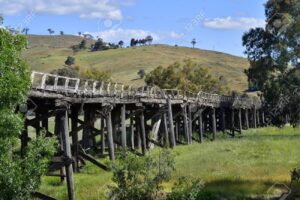
So, there we were. I was in the car with the boys; my wife in the back of a Good Samaritan’s station wagon with the unconscious child. It was raining but I took a robust approach in speeding towards Gundagai. Then we came to the long wooden bridge across the Murrumbidgee River and flood plain. For some reason there was a long line of cars queuing to cross the bridge. I took a chance and with horn blaring dashed down the wrong side. For some reason there were no cars daring to cross, but right near the end of the bridge my car skidded on the slippery wooden surface. It is a situation where the sub-cerebral instincts kick in, and for some miraculous reason I did not fly off the bridge. It is a long way down to the Murrumbidgee River flood plain.
Anyway, we arrived at the hospital. Gundagai, at that time, had a strong procedural base, and our appearance caused the general practitioners at the hospital preparing for their operating theatre list to pause.
The child was bought in, and we handed his care over to the Gundagai practice. To them it seemed all in the day’s work – no fuss – just a slight annoyance of having their routine upset – we were waved away. As for me, irresponsible, driving as I did with two unrestrained children. It was a sign of the times; I do not sweat when I remember the incident.
In any event, that was the last we heard of it, apart from me telephoning the hospital next day and being told that the child was still there, and there were no concerns. For a while I scanned the papers for a coroner’s report. There was nothing, or I missed it.
Twenty-five years later, when I was reviewing the NSW Ambulance Service, the transition from ambulance driver to allied health care professional had begun. Change is a slow process, especially in inward-looking uniformed services.
I was reminded of that escapade this week when I saw images of this 800 metre long wooden Prince Alfred bridge being dismantled, its boarded heritage clattering to the ground with a promise to retain the section which actually crossed the river. The extensive flood plain now has not only a sweeping four lane highway bypassing the town, but also, for some reason, a large dead gum tree poking above the road parapet, painted in a garish blue. Why?
By the way, I picked up my first speeding fine on my way back from Sydney in early 1958. Five pounds for fanging through Albury. The police motor cyclist caught me after I had entered Victoria. Those were the days. I did not protest, Smokey said I deserved it.
The Use of the Car as a Weapon
Iowa is one of three states, along with Oklahoma and Florida, to enact laws this year giving drivers some degree of legal immunity if they use their vehicles to hurt protesters, part of a wave of “hit and kill” bills introduced in 13 other states by Republican legislators since 2017 (as shown in the figure below). Most of those proposals came after one of the most sustained periods of demonstrations in US history following George Floyd’s murder, and the effort to crack down on protesters has sent a chilling message to activists, who believe it will encourage violence against them. – Boston Globe.
Yet another example of the reversion of America to the glorification of violence – the staple diet of American fantasy.
Marching along streets and roads has been a characteristic of protests in particular of African-Americans but not exclusively.
In the year after the George Floyd incident, The Boston Globe found across America 139 cases of cars being deliberately rammed into people. Only 65 of these have been taken to court, with only four convicted of a felony. One hundred people have been injured and four killed. Not a huge number, some would say; but wait a minute, deliberately using the car as a weapon!
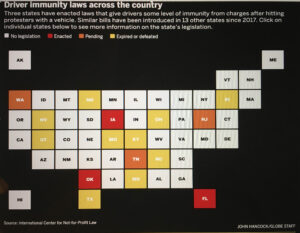 Yet the legislators in essentially very Republican states run the line of driver being surrounded by violent rioters and in trying to get away, some of the pedestrians may be hit by the car, where the driver at risk feels his or her life in danger. The thesis plays the white audience which spawned a person like James Field who, well before the George Floyd murder, in 2017 ploughed his Dodge Challenger into a crowd of demonstrators in Charlottesville, South Carolina, only stopping when he struck a white Camry, which was pushed in turn into a maroon minivan.
Yet the legislators in essentially very Republican states run the line of driver being surrounded by violent rioters and in trying to get away, some of the pedestrians may be hit by the car, where the driver at risk feels his or her life in danger. The thesis plays the white audience which spawned a person like James Field who, well before the George Floyd murder, in 2017 ploughed his Dodge Challenger into a crowd of demonstrators in Charlottesville, South Carolina, only stopping when he struck a white Camry, which was pushed in turn into a maroon minivan.
As was described, this young man had driven nine hours from his home south of Toledo in Ohio to be there to kill – this person was described by one of the victims, as she lay half under the car with a smashed leg, as having lifeless eyes. Fields was later convicted and given two life sentences. Would legislation to protect the driver have made any difference to the outcome for the victims? I doubt it.
Yet despite this crime, these States are endeavouring to twist the narrative to the protesters not the driver being the villains. As such, it would be somewhat ironic if such a law protected protesters at a far right rally with its pronounced anti-vaccination bias, such as those who surrounded vehicles on the Bolte Bridge in Melbourne and deliberately caused damage to them.
The problem with this legislation is perspective and from any perspective this legislation is wrong-headed.
Mouse whisper
As recounted in Harper’s Magazine February 2005
A story headlined “Syria seeks our help to woo U.S.” in Saturday’s Weekend Australian misquoted National Party senator Sandy Macdonald. The quote stated, “Syria is a country that has been a bastard state for nearly forty years,” but should have read, “Syria is a country that has been a Baathist state for nearly forty years.”
The Australian regrets any embarrassment caused by the error.
I doubt there would be any apology forthcoming now – defence in truth.
